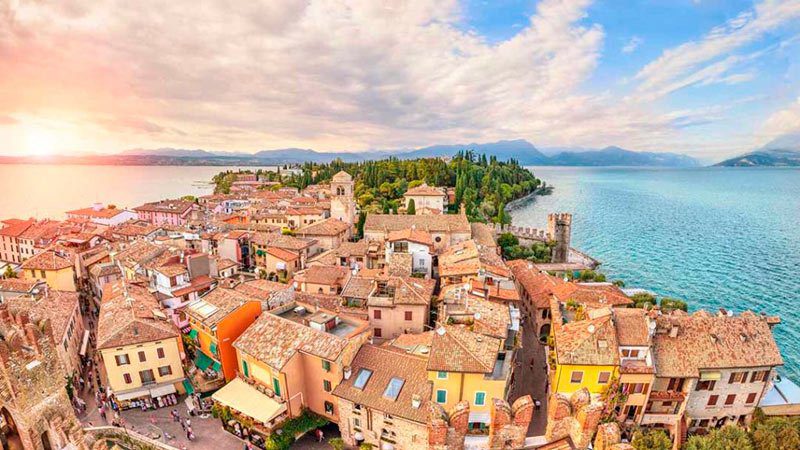Milan, the birthplace of the world-famous La Scala opera house, Armani, and fashionable boutiques, is the second most sought-after tourist city in Italy after Rome. You can diversify your stay with trips to its surroundings and neighboring cities. There are many irresistibly attractive places with a rich past and beautiful nature. No wonder Hollywood celebrities choose these places for permanent residence. This article provides recommendations on where to go from Milan for a one-day trip on your own. Google Maps can help you navigate any city.
Bergamo
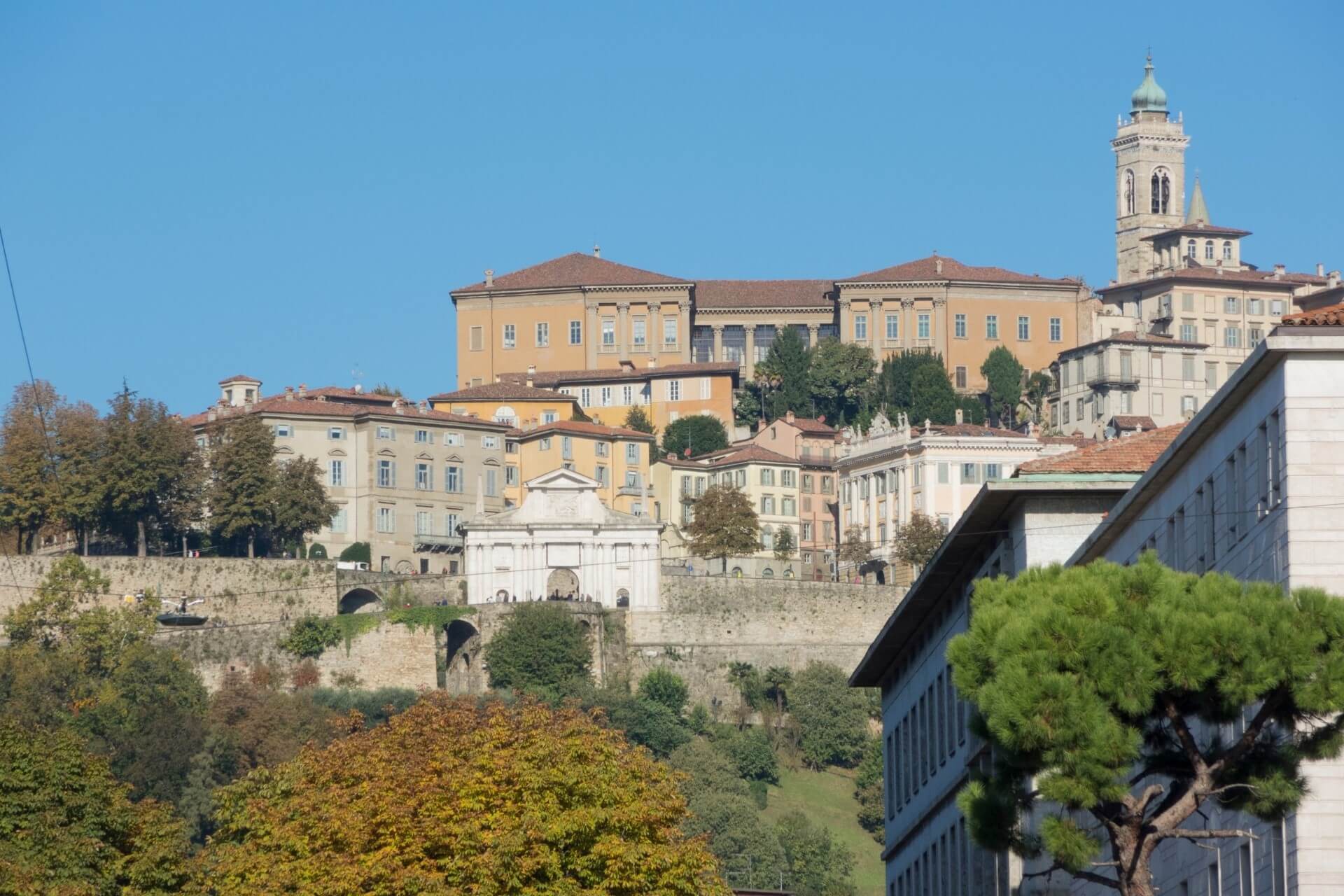
This name immediately brings to mind Goldoni’s play “Truffaldino from Bergamo” and Konstantin Raikin, who brilliantly played the main role in it. There are seven ways to travel to Bergamo: train, bus, metro and bus, taxi, rental car, Uber. Economically, it is more profitable to take the Re 2 train from Milano Centrale station.
Google Maps will help you navigate the city and plan your route. Upon arrival at the station, you can buy a day pass and freely use all types of public transport. The jewel of Bergamo is the Upper Town (the old center), a must-visit. At Piazza Vecchia, you will see medieval structures: the Contarini fountain with lion sculptures, the magnificent Town Hall building, and the Torre del Campanone tower.
Passing through the arch, you will find yourself in the neighboring Piazza Duomo, where the very beautiful main cathedral of Bergamo, Duomo di Bergamo, is located. Here is also the church of Santa Maria Maggiore, which you can visit for free. In the Colleoni Chapel, adjacent to the church, rests the ashes of General Bartolomeo Colleoni. In the warm season, it is worth visiting the extraordinarily picturesque Botanical Garden. Near the station of the second funicular is Citadella square with two free museums.
Take the funicular up to the San Vigilio fortress. From its observation deck, you can enjoy a stunning panorama. In the Lower Town, the art gallery deserves attention, with ten exhibition halls displaying paintings by famous artists of the 16th-19th centuries. You can have a delicious meal in any of the numerous dining establishments for an average of 20-30 €.
Verona
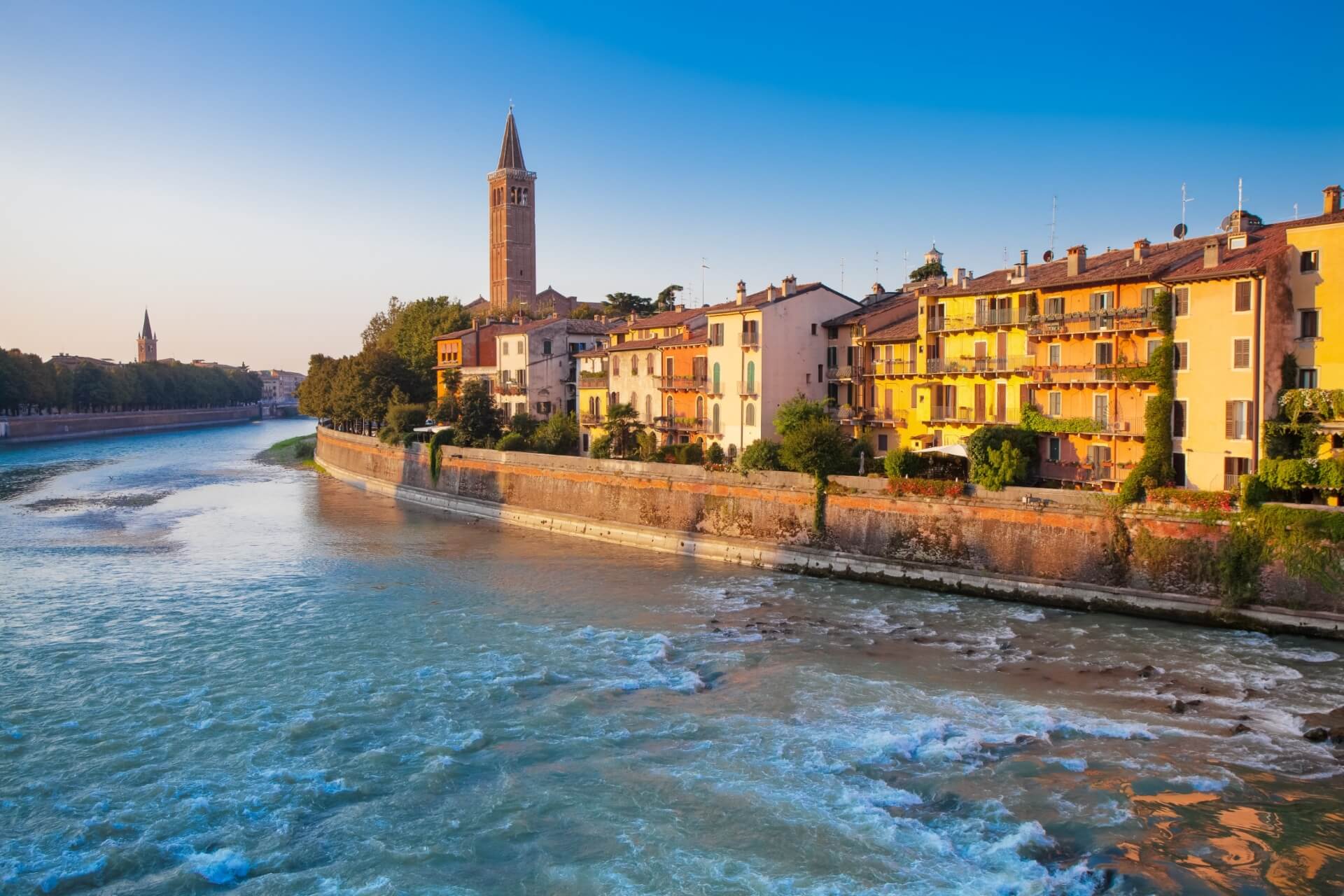
The homeland of Romeo and Juliet is 160 km away. The easiest way to get there is by high-speed Italo Treno, departing from the central railway station, for example, at 8:34 AM. To save money, it is worth buying a ticket in advance. In 1 hour and 14 minutes, you will be in the legendary Verona, rich in architectural and religious monuments.
Among them is a bright example of Gothic architecture – the Basilica of San Fermo. The striped facade of the church catches the eye from afar. Inside is a real art museum with the famous sculptural composition “Lamentation of Christ” and the fresco “Madonna on the throne with a baby and two saints.” In the upper halls of the basilica is the mausoleum of the members of the Della Torre family.
The museum castle Castelvecchio, another monument of Gothic architecture, is a treasure trove of 14th-century paintings located on the banks of the Adige River. Your imagination will be struck by the Giusti palace and landscape complex among the hills in the east of Verona.
The exquisite palace is surrounded by the most beautiful “Italian” gardens of the Renaissance with century-old cypresses, statues, and stunning landscape patterns. It will be interesting to visit Signoria or Dante square, where the 12th-century Scaliger Arches, royal sarcophagi, the Dante monument, the Palace of Justice, and others are located. The “painted” Cathedral of Verona with colored marble and other churches will impress you.
Sirmione
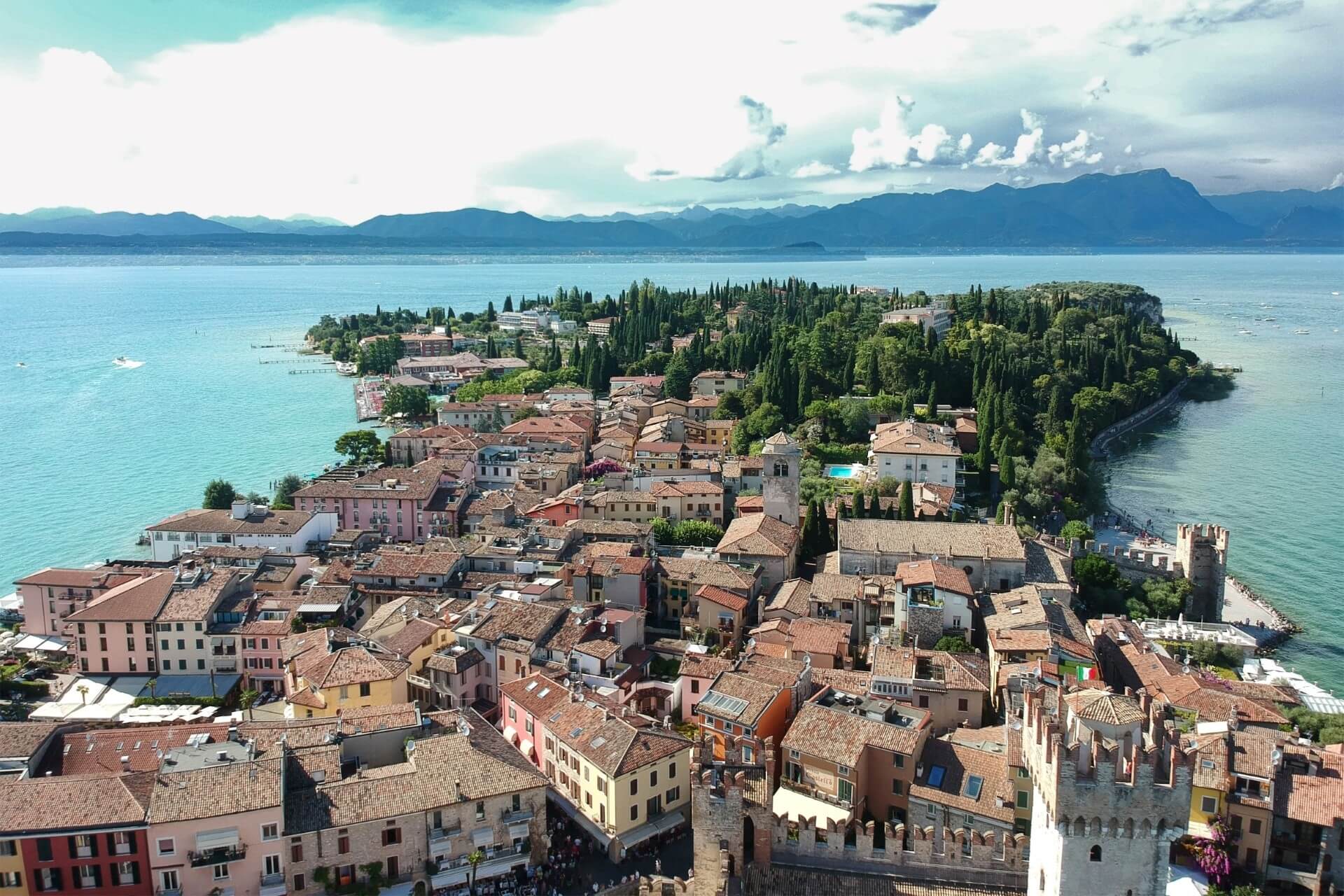
The charm of the blue Lake Garda and the authentic town with an ancient fortress awaits you in a trip to Sirmione. It is located on a narrow peninsula jutting out into the lake. The most convenient way to get to the town (if you do not plan to rent a car) is by train from the central railway station. It travels for 1.25 hours, arriving at the Desenzano Del Garda-Sirmione station.
Transfer to a city bus, and in a few minutes, you will enter the town. At the entrance to Sirmione, get off to see the 13th-century Scaliger Castle. The crenellated walls and watchtowers of the powerful fortress take you back to the Middle Ages. Everything in this museum, where you can walk along the walls, climb the observation deck, breathes cozy antiquity.
Stop by the pier at the thermal hydrogen sulfide spring. Leaving the fortress, take a walk along the pedestrian street Corso Vittorio Emanuele. There are many souvenir shops and stores where you can buy something as a memory. You can have a relatively inexpensive snack in one of the cafes away from the busy tourist routes, where prices are lower.
The ancient 15th-century church of Santa Maria Maggiore, whose interiors are decorated with old frescoes, will undoubtedly be of interest. Another remarkable church is the Lombard church of San Pietro in Mavino with a Romanesque bell tower. The unique ancient Roman monument “Grotto of Catullus” – the ruins of a once luxurious estate surrounded by olive groves – deserves attention.
Iseo
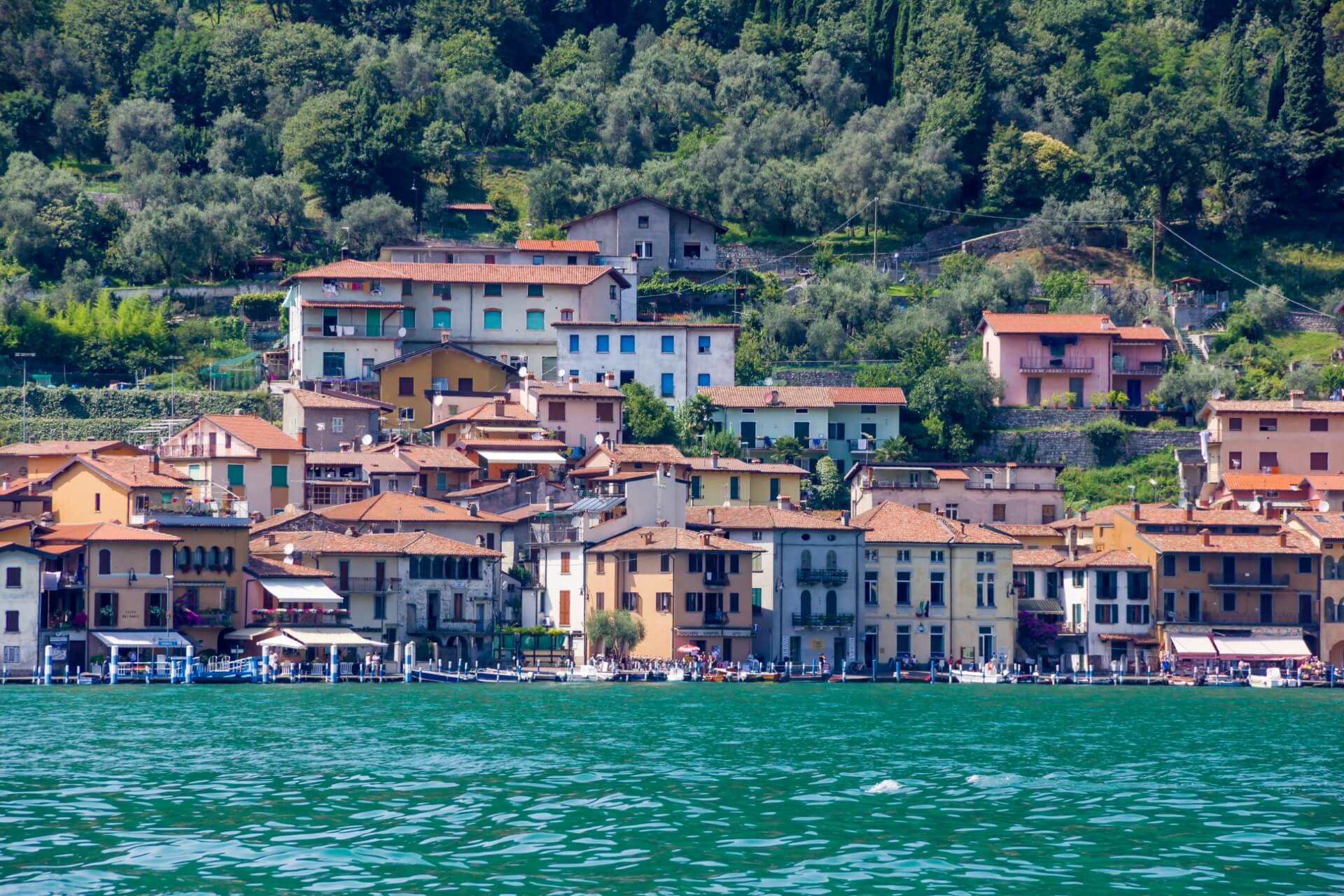
A truly magical panorama opens up before everyone who visits Lake Iseo. It is more convenient to get there by car, using an online car rental service. But there is also a railway connection – a train with a transfer in Brescia (schedule and prices on the Trenitalia website). Charming towns (Iseo, Lovere-Castro, Sarnico, Pisogne, and others) surround the 25 km long and 5 km wide lake.
In each of them, some product is produced: olive oil, milk, meat, wine. They can be visited in a day, stopping in some of them. Lovere amazes with its houses with frescoes on the facades and bright shutters on the windows. In Sarnico, you can walk through authentic medieval quarters and admire luxurious Art Nouveau villas.
Pisogne, where almost every house is entwined with wild grapes, will delight you with abundant greenery. In the city of Italian champagne Franciacorta, famous for its wineries, you can buy a bottle of signature wine. If time and budget allow, you can take a tour, for example, to the Berlucchi winery (20€), where you will be offered three glasses of champagne with snacks.
The same-name town of Iseo will pamper you with beautiful views. Among the attractions in these towns, the most interesting are the Bishop’s Tower (12th century), the church of Santa Maria in Valvendra, St. Peter’s Cathedral, the Pinacoteca of the Tadini Academy, the chapel of Madonna della Ceriona, the commune of Capo di Ponte with rock carvings (10 thousand years BC).
Genoa
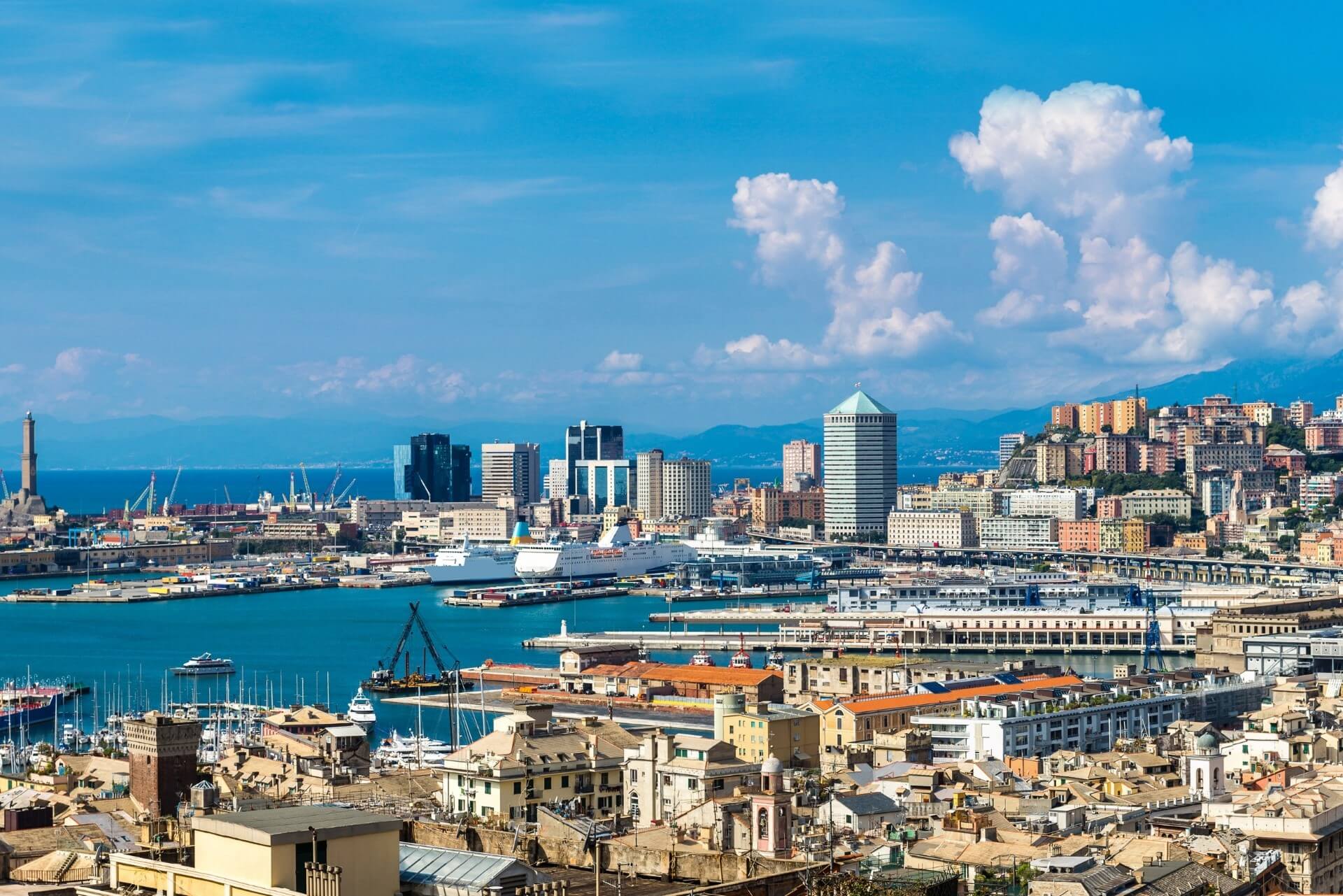
How can you not visit Genoa, famous for its merchants, where the unrivaled violin genius Paganini and the great discoverer Columbus were born?! The best way to go to the beautiful dream city is by Trenitalia train. They run frequently and quickly, and a discounted ticket is sold on the Russian-language website Omio. The first point of the route in the ancient port city is the waterfront and port.
There is plenty to see here even for seasoned tourists. The huge Aquarium, the magnificent replica of the 17th-century ship “Galleon Neptune,” the Galata Museum, the Biosphere, and the Panoramic Elevator – each of the attractions is unique.
Passing Piazza Caricamento, you will see the inimitable 13th-century San Giorgio Palace, which is hard to look at without admiration. Bright sculptures and picturesque frescoes adorn the facades of the building. From it, you go along St. Lawrence Street to the main cathedral of the same name, which is extraordinarily beautiful. After enjoying the cathedral, head to the central Piazza De Ferrari. On the way, you will see Porta Soprana – medieval gates.
In one of the corners hides the modest house of Columbus. On Piazza Ferrari, you will admire the most beautiful buildings around its perimeter: the Doge’s Palace, the Opera House, and others. Walking through the Palace Quarter, you will be astounded by the view of the luxurious buildings – the palaces of the Genoese aristocracy.
Turin
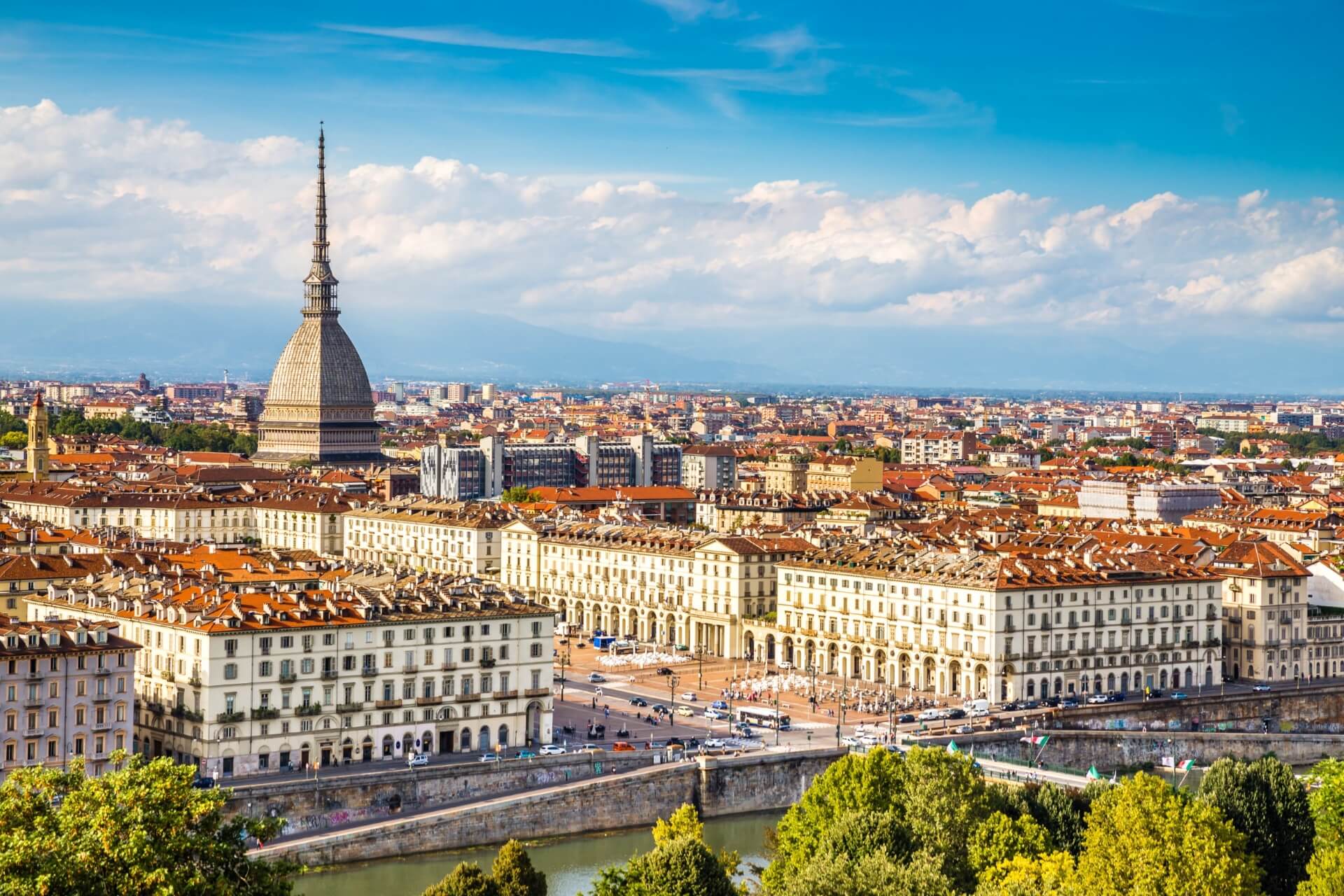
The oldest city in Italy became close to Russian sports fans in 2006 during the Winter Olympics. Express trains from Italo and regional trains from Trenitalia run daily to Turin. If you do not need to save money, buy a ticket at the machine at the central station, get on the train, and in 1 hour and 15 minutes, you will be in the capital of Piedmont.
In one day in the “city of royal residences” and the “Turin Shroud,” you will see the most interesting objects of the historical center. The first is Piazza Castello, with the Palazza Madama fortress from the 13th century, the royal Reggio theater, with the Royal Armory, three grand monuments, and four fountains. On Via Palazzo di Citta is the court church of St. Lawrence.
The Royal Square is marked by the brilliant Royal Palace (19th century), with gardens, fountains, sculptures, and many halls. The austere facade attracts with the elegance of the neoclassical style, while the interiors (30 rooms) impress with the splendor of Baroque and Rococo. Immediately behind the Royal Palace is the temple of St. John the Baptist, where the relic “Turin Shroud” is kept in an attached chapel.
In the riverside area of the Po River stands the beautiful palace – the Valentino Castle (18th century). Initially, it was a fortress named after the patron saint of lovers, whose relics were kept in the church of St. Vitus (now not preserved).
Bologna
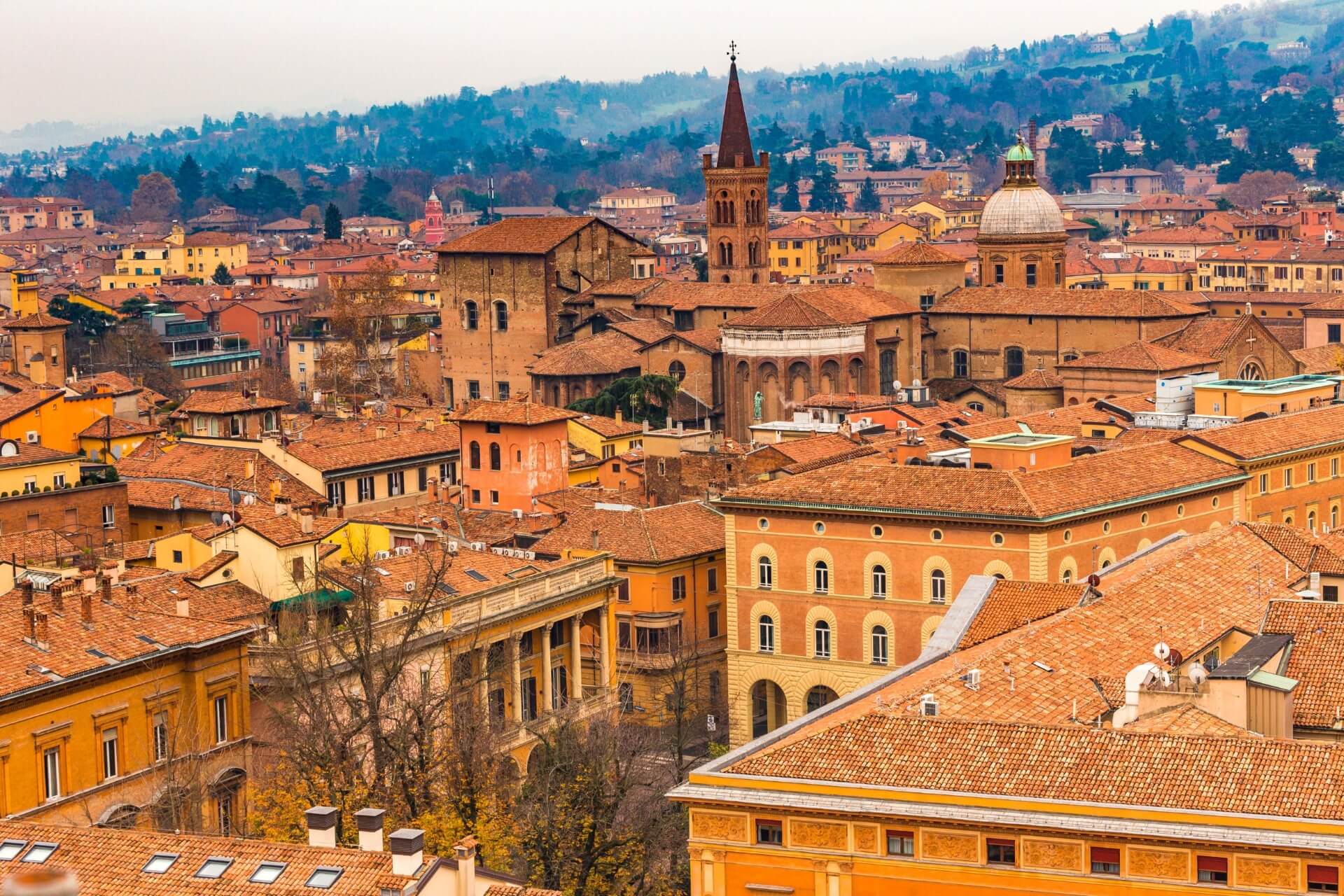
Bologna, like all Italian cities, has its “highlights.” The main city of the gastronomic region of Emilia-Romagna is known for the production of premium-class cars, exquisite wines, Parmesan cheese, and other exclusive products. The concentration of attractions makes the city an open-air museum.
The cheapest way to get to Bologna is by comfortable FlixBus buses, making many trips (from 4.25 AM to 2.15 AM) from the Lampugnano bus station. Travel time is 2.5 hours. To see the iconic sights of the city, you should head to the Big Square (Piazza Maggiore), the former market (13th-18th centuries). The oldest building here is the Town Hall with a high bell tower Arengo. To the south is the church of St. Petronius – a beautiful example of Gothic architecture.
On the west side is the Accursio Palace, which houses the Morandi Museum of Painting. Next to Piazza Maggiore, the monumental Neptune Fountain, located on the square of the same name, will attract attention. You cannot pass by the famous 13th-century towers – the Leaning Towers of Asinelli (97 m) and Garisenda (48 m). Today, 20 of such structures remain from 80.
Almost all of them are concentrated around the squares. The monastic complex of St. Stephen (St. Stephen’s Square) impresses with its churches: the Crucifixion, Saints Vitalis and Agricola, the Holy Sepulchre, and the Trinity. An interesting tourist object is the House of Isolani (Via Maqqiore), shrouded in legends. Overwhelmed by aesthetic emotions, you will add to them carnal pleasures during lunch with the tastiest national dishes.
Padua
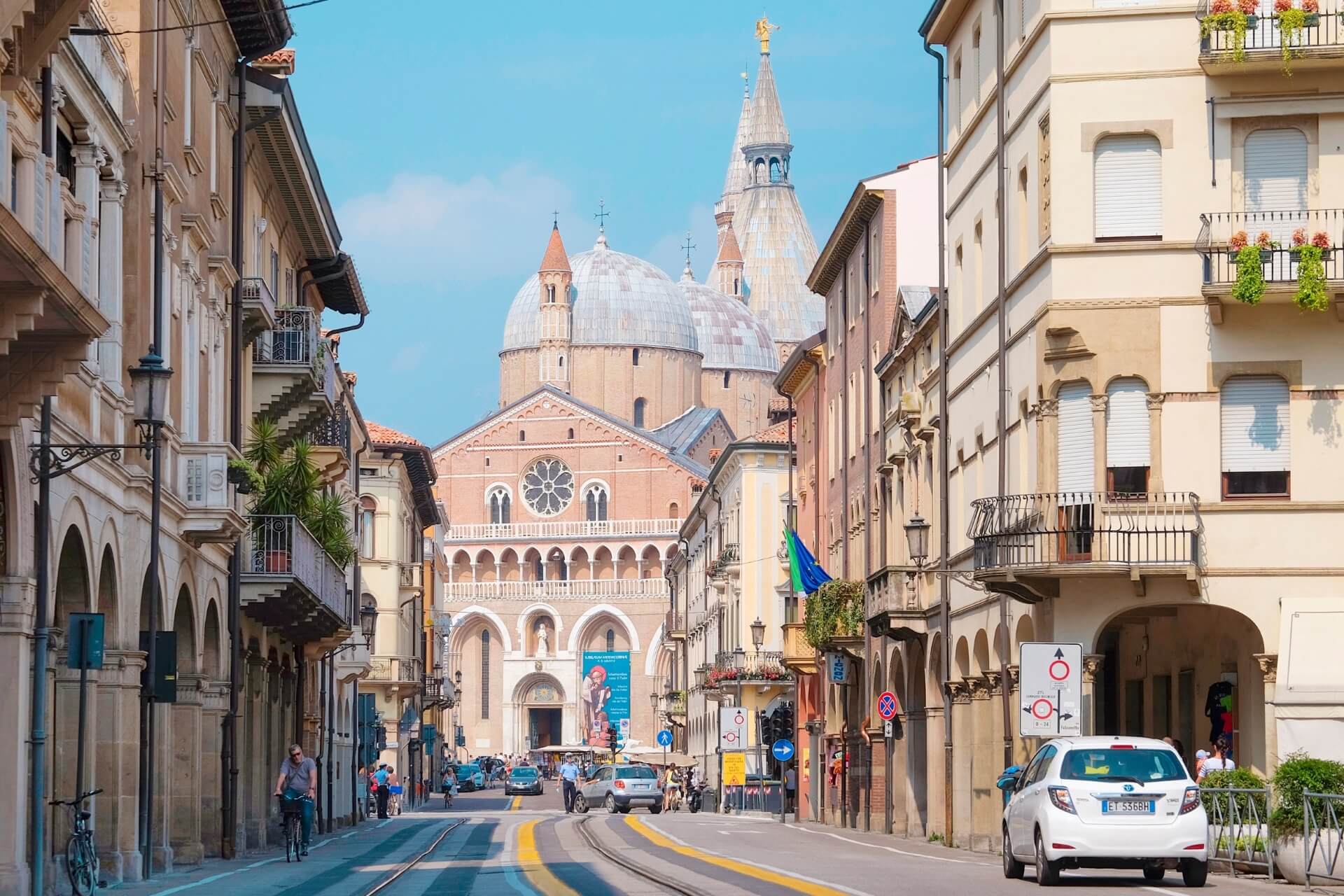
The special color of the cheerful student city with the oldest university in the country, late Gothic architecture, and a network of canals can charm the most sophisticated tourist. And getting there will not be a big problem. Fr trains depart from Milano Centrale station to Padua, travel time is 1.59 hours. Upon arriving in the ancient city (12th century BC) of the Veneto province, start your tour with the historical part of Padua.
Here, separate sections of powerful defensive walls, organically integrated into the modern architectural look, have been preserved. A peculiarity of the old center is the 12 km of covered galleries-arcades, decorated in various styles, allowing you to explore the sights during the rain. The Scrovegni Chapel, a sacred object for Catholics, impresses with the famous frescoes by Giotto (14th century), a masterpiece of world art. The fresco plots depict the detailed history of Christ’s life.
Otherwise, the Scrovegni Chapel is called dell’Arena because next to it, during excavations in the 17th century, the ruins of a Roman amphitheater (27 BC) were discovered. Prato della Valle square is also located on the site of a Roman amphitheater built in 60 AD. The largest square in Italy and Europe is adorned with 78 sculptures of respected residents and guests of Padua: Galileo, Livy, Petrarch, and others.
They are located on pedestals around the elliptical canal with bridges and a green island inside. It is worth visiting Signoria square with the Admiralty and the Triumphal Arch, the Duomo with the Cathedral, the University of Padua to get a more complete picture of this extraordinary city.
Venice
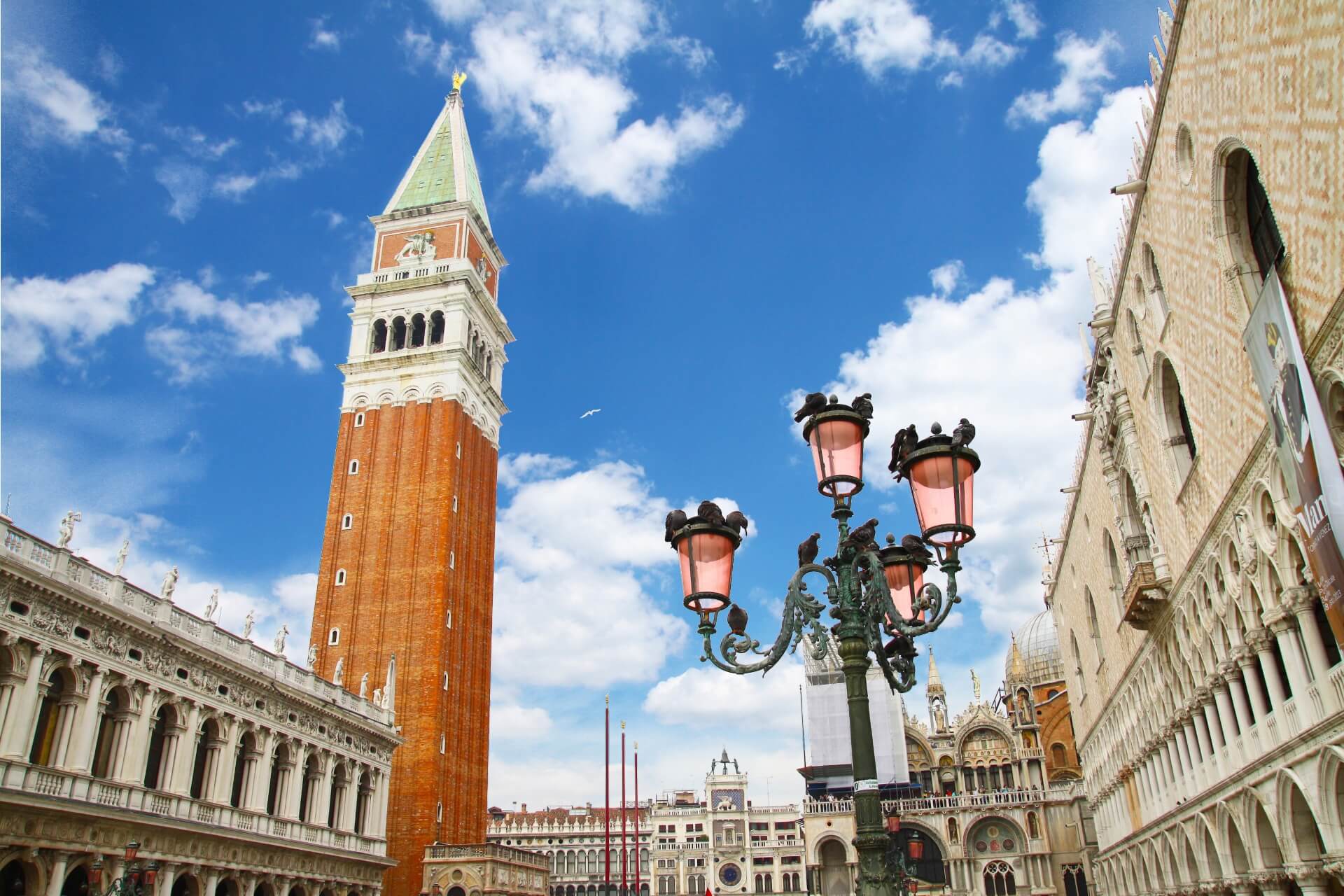
The most romantic city on water, mysterious and unique, attracts with its unique beauty and incredible architectural monuments. You can get to Venice in 3 hours by renting a car without adjusting to the train and bus schedule. Trains depart from the central railway station and Rogoredo from 5 AM every 2 hours, traveling for 2.5 hours. Leaving the Santa Lucia station building in Venice, you will see the magnificent Scalzi bridge.
You can start exploring the city with a walk on the vaporetto along the Grand Canal, along which 200 luxurious palaces (palazzo) are located. You should get off at San Marco square pier – the heart of Venice. Here is the cathedral of the same name, where the relics of the saint are kept. Immediately, the magnificent 99-meter bell tower will catch your eye, where it is worth climbing to observe the city panorama.
It was at the top of the bell tower that Galileo first showed his telescope to the republican rulers (early 17th century). The “Angel” descends from it on the day of the Venetian Carnival. The elegant beauty of the Doge’s Palace amazes and impresses the imagination. Walking along the Riva degli Schiavoni to Campo Zaccaria street, you will see the church of San Zaccaria with the relics of Saint Zacharias, the father of John the Baptist.
It is impossible to see all the churches of the city, of which there are over 150. It will not be superfluous to see the Gothic cathedral of Saints John and Paul, the oldest church of San Giacomo di Rialto, the Church of Santa Maria Gloriosa dei Frari, the church of Santa Maria della Salute. You cannot miss a walk along the Rialto bridge, a visit to the Accademia gallery with the richest collection of art from the 13th-18th centuries.
Stresa
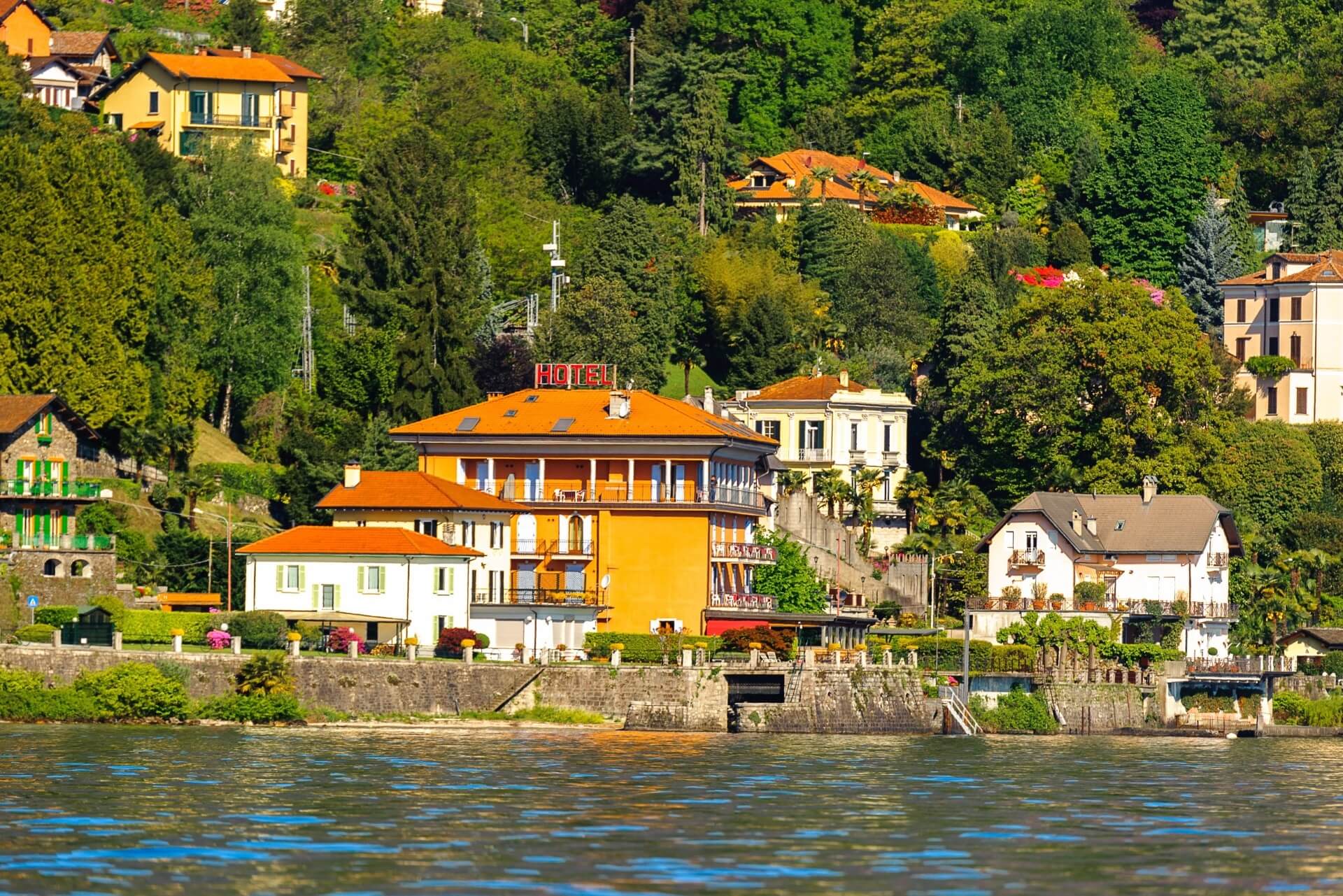
The town of Stresa on the shore of the beautiful Lake Maggiore is truly a paradise. The incredible charm of nature in Stresa harmonizes with the landscape-architectural beauty of buildings, squares, and parks. No wonder Hemingway, Byron, Shaw loved to come here, and villas were built by George Clooney, Ronaldinho, and other celebrities. The historical center of the city is located on the shore, the rest are on three Borromean Islands. You can come here by Trenitalia regional train, the first train leaves at 5 AM.
The Stresa station is located on a hill, all roads lead to the lake past the most beautiful villas and old hotels. The magnificent Alps surround the blue surface of the lake, with city buildings scattered at their feet – the views are breathtaking. Walking along the pedestrian zone with comfortable benches, past the extraordinarily picturesque hotel territories is a great pleasure.
After admiring the architectural masterpieces of the 19th century in the historical center of Stresa, it is worth taking a boat trip to Isola Bella. Tickets are sold at the box office, but you can order an individual excursion at one of the stalls before the pier. Not only the beauties of Isola Bella attract tourists, but also the 13th-century monastery of Saint Catherine, the main attraction of the island. It is important to remember that the monastery is closed from 12:00 to 14:00.
Luino
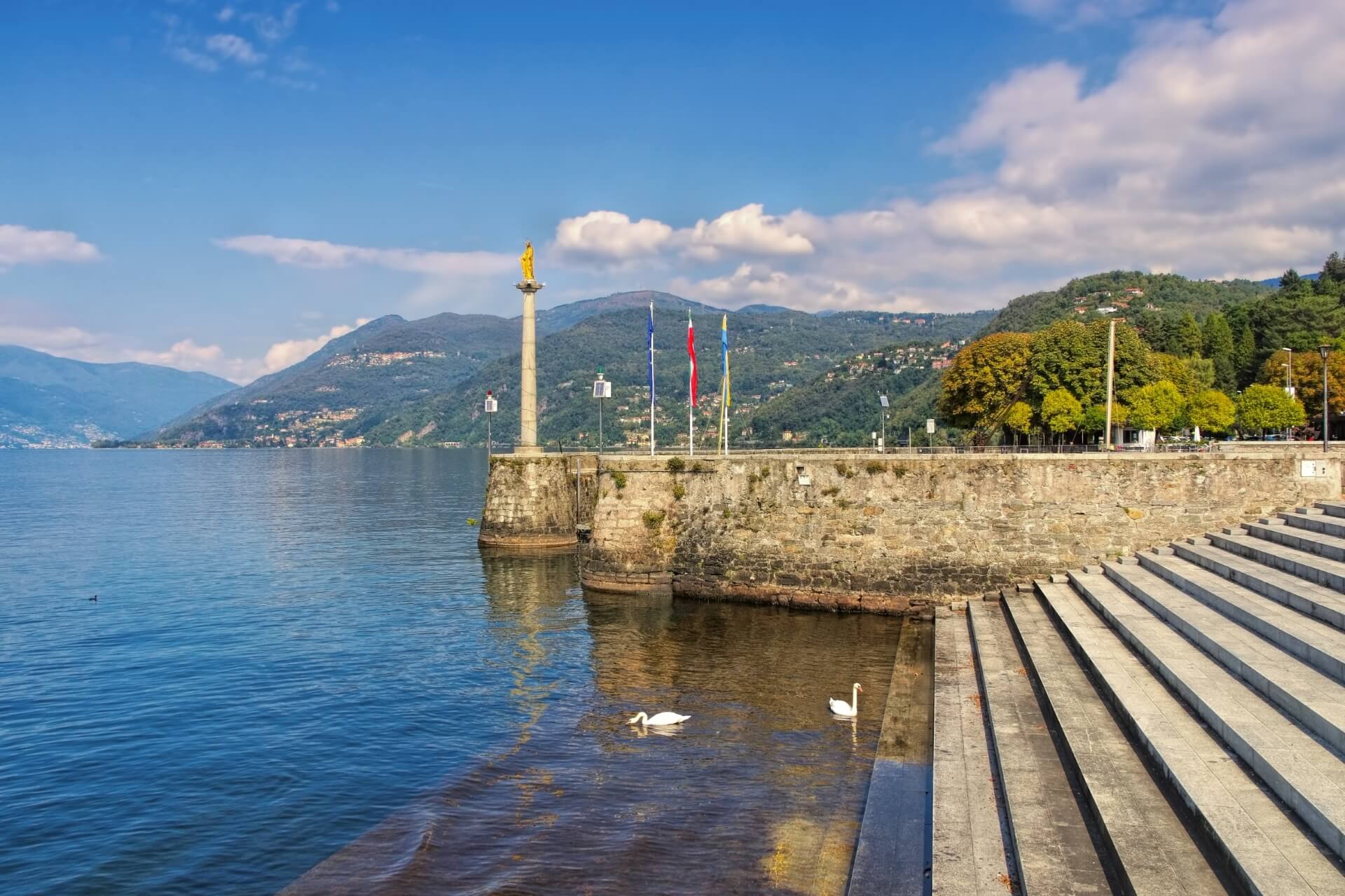
The small charming town of Luino on the shore of Lake Maggiore, bordering Switzerland, originated in Roman times. The most convenient option for a trip to Luino is by regional train from the Milano Porta Garibaldi station. The journey takes an average of 1 hour and 30 minutes. Like all local settlements, Luino enchants with its surrounding landscapes, magnificent villas, and unique authenticity.
The culture, lifestyle, and mentality of the townspeople bear the imprint of Swiss, Austrian, and Italian influences, which gives the town a special appeal. Tourists stroll along the beautifully decorated promenade, admiring the lake and majestic mountain views. The modern promenade is the pride of the Luino residents, a modern project by architect Marforio.
Traditionally, all visitors ride boats and ships on the lake and then immerse themselves in the historical atmosphere of Luino. Visiting local monuments and landmarks provides bright impressions. It is interesting to visit the church of Santuario Beata Vergine del Carmine and other cathedrals. Visiting one of the local restaurants will be a great pleasure.
The most popular here is the family restaurant with a 150-year history Al Cantione. Located in the very center of Luino, the authentic establishment has known many celebrities. Film scenes were shot here, famous writers and directors dined. The menu includes many fish dishes, pasta with cheese, and wonderful desserts. You can visit the local flea market if it is a weekend.
What to See in Milan – 19 Most Interesting Places
Fishermen’s Island
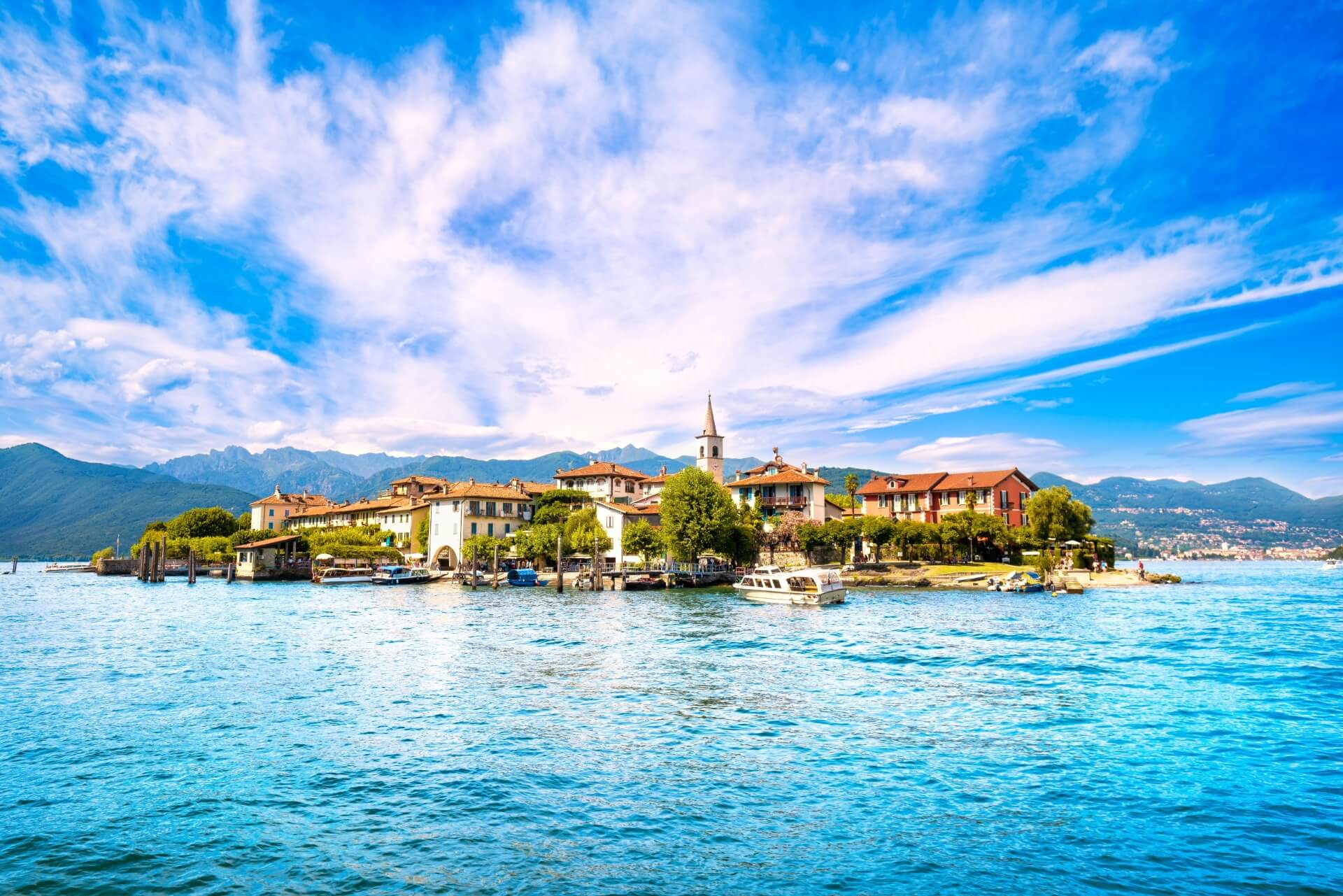
Small boats and ferries go from all the coastal towns on Lake Maggiore to the tiny island (375×100 m). You can easily find yourself in the atmosphere of a piece of earthly paradise in the middle of the water from Stresa, Luino, Laveno, and others. On Fishermen’s Island, where 50 people live permanently, there are no cars, and there is a soothing silence. Its territory is occupied by fishermen’s houses (about 100), restaurants, cafes, and bars. In recent years, tourists have been actively visiting the fairy-tale island, and the locals are happy to welcome them.
In restaurants and cafes, dishes from the freshest fish and seafood are served. Unique handmade items are sold in souvenir shops and boutiques. The main attraction of the island is the church of San Vittore, built in honor of Saint Victor Maurus. Interesting relics inside are 16th-century frescoes, an altar with four busts of 17th-century bishops, and the remains of an 11th-century chapel. One of the bishops, Saint Charles Borromeo, gave the name to the archipelago.
Orta San Giulio
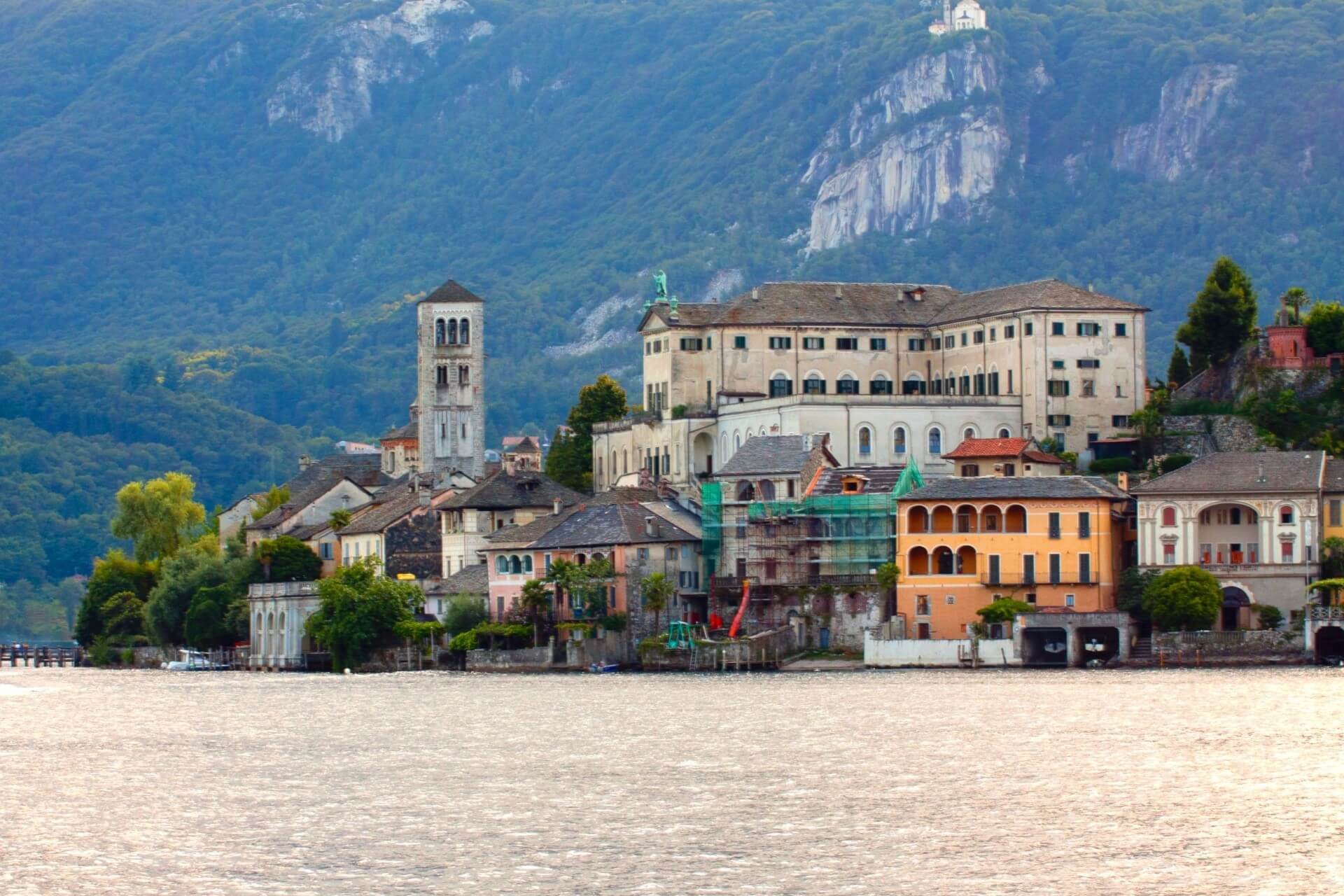
A trip to Orta San Giulio will allow you to see the beauty of the alpine Lake Orta, where, according to legend, dragons lived, admire the stunning views of the Alps and the architecture of the tiny island. The easiest way to get there is by renting a car: there are no transfers, and the journey takes 60 minutes. Even if it costs a few euros more than by train or bus, it is much more convenient.
It is worth visiting Orta San Giulio for its absolutely irresistible views and medieval monuments. On the island of San Giulio, there is only one street, “The Path of Silence,” where unique attractions included in the UNESCO heritage list are located. Each building here is marked by a philosophical saying posted on a plaque.
Today, some buildings (the Bishop’s Palace, the Benedictine women’s monastery) are closed for restoration. Open to visitors are the 16th-18th century churches, the monastic library, and the Basilica of Saint Julius. According to legend, the Greek Saint Julius drove dragons from the island, as depicted in the 15th-16th century frescoes. As a raft for the crossing to the island, Julius used his cloak and destroyed the dragons.
Lecco

The romantic city of Lecco, with a complex historical fate, is located in the picturesque surroundings of Lake Como, where two rivers (Adda and Lario) form the small Lake Garlate. The panorama of whimsical rocks surrounds Lecco, making it an alpine destination. There are excellent lifts, and a group of local renowned climbers is aptly called “Spiders.”
You can come to Lecco (78 km) by train, rented car, or taxi. On the Re 8, 10 train from Milano Centrale, or bus 157 (station Piazza del Duomo), travel with a transfer, increasing the distance and price. If you rent a car profitably, you will get there in 60-65 minutes. Lecco, which became a province of Lombardy in 1992 and was once famous for silk weaving and later for steelmaking, is now a sports-tourist resort.
The old center does not have ancient castles and palaces; it mainly consists of neoclassical buildings from the 19th century, designed by G. Bovara. The main attractions are located on the central Piazza XX Settembre. The Church of St. Nicholas with the highest bell tower in Italy, Palazzo Stracca – a museum. It is interesting to walk through the streets named after Giuseppe Bovara and Rome with a watchtower, shops, and restaurants.
Nesso

Everyone who visits this authentic town on Lake Como feels that Nesso has not been touched by the frantic pace of modern life. Here, life flows smoothly, peacefully, on ancient streets with stunningly beautiful architecture. To find yourself in a medieval fairy tale, you need to take train 10 at the Central Station.
Travel to the Como S Giovanni station (36 minutes), then walk to the Como San Giovanni station. There, take bus C30 (40 minutes) and get off at the Nesso stop. The most popular natural attraction among tourists is the dell Orrido waterfall, pouring crystal streams against a background of lush greenery. Despite its small area, Nesso pleases with its architectural landmarks. The ancient arched bridge of the Roman era is impressive.
It is interesting to visit the 12th-century church of San Martino with a majestic bell tower. The church of Santa Maria in Vico is worth seeing for paintings by Benzi. The 17th-century church of Saints Peter and Paul will amaze you with its baroque decorations. Not far from it is the Mazero cave – a mysterious hydrogeological formation. You will undoubtedly enjoy lunch in one of the local restaurants, where hospitable hosts will feed you fish dishes.
Como
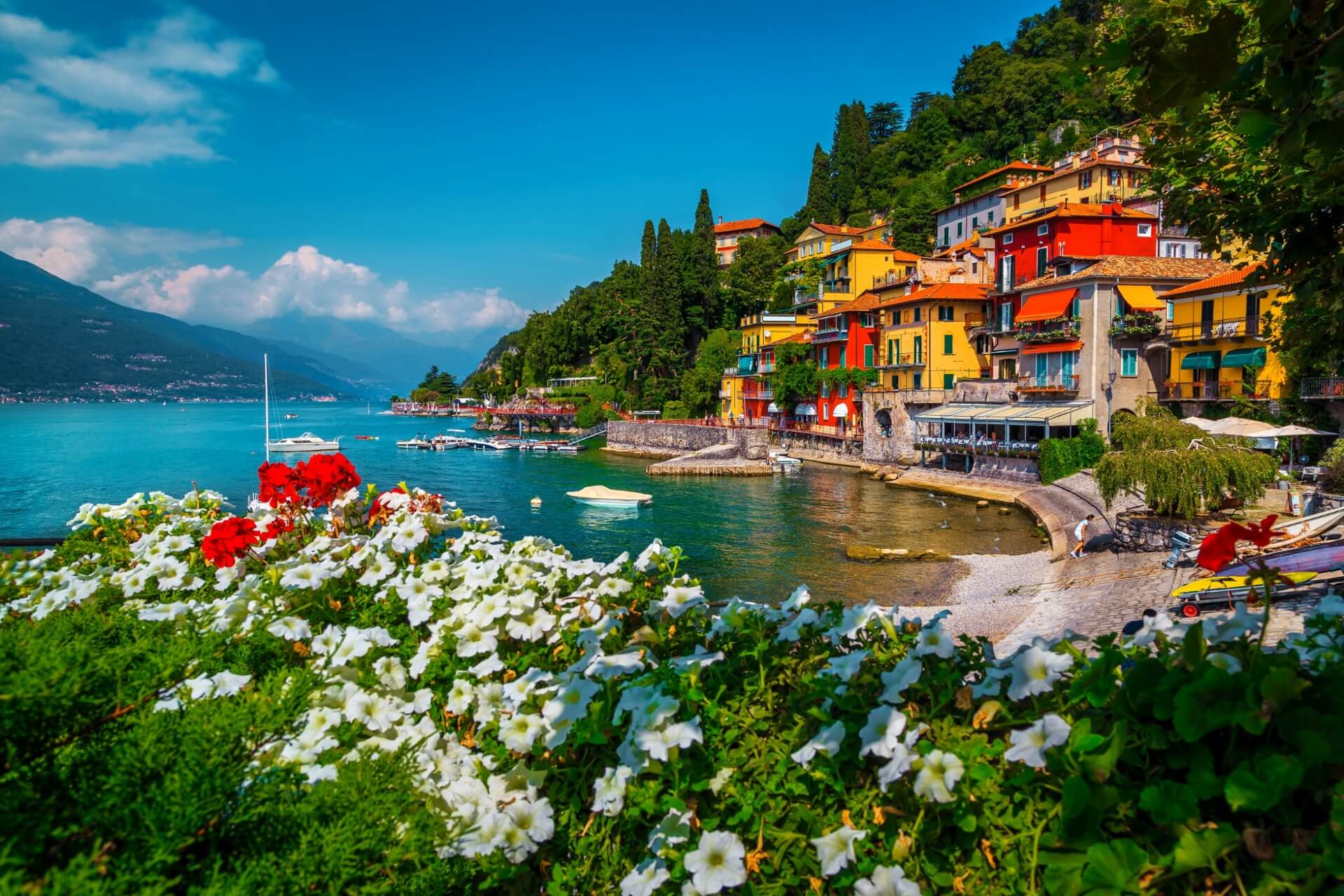
The resort jewel of Italy – Lake Como is becoming increasingly attractive worldwide. Charming towns and luxurious villas of Hollywood and football celebrities, millionaires, and billionaires surround it from all sides.
A trip to the city of Como, located on the southwestern shore, will allow you to see not only interesting monuments but also the irresistible beauty of the lake’s surroundings. Trains depart from three stations, starting at 5:29 AM until 12:25 AM. The extraordinarily picturesque city enchants with its old villas, castles, and churches.
The center of Como is a concentration of churches and palaces. Among them is the Cathedral of Santa Maria Assunta, impressing with its exterior and interior decorations, and the Basilica of Sant’Abbondio. The Broletto Palace is noteworthy. It is worth visiting the A. Volta Museum and Baradello Castle. Walking along the promenade, you can see the magnificent Villa Olmo. Then take a boat ride on the lake and admire the stunning coastline.
Varenna
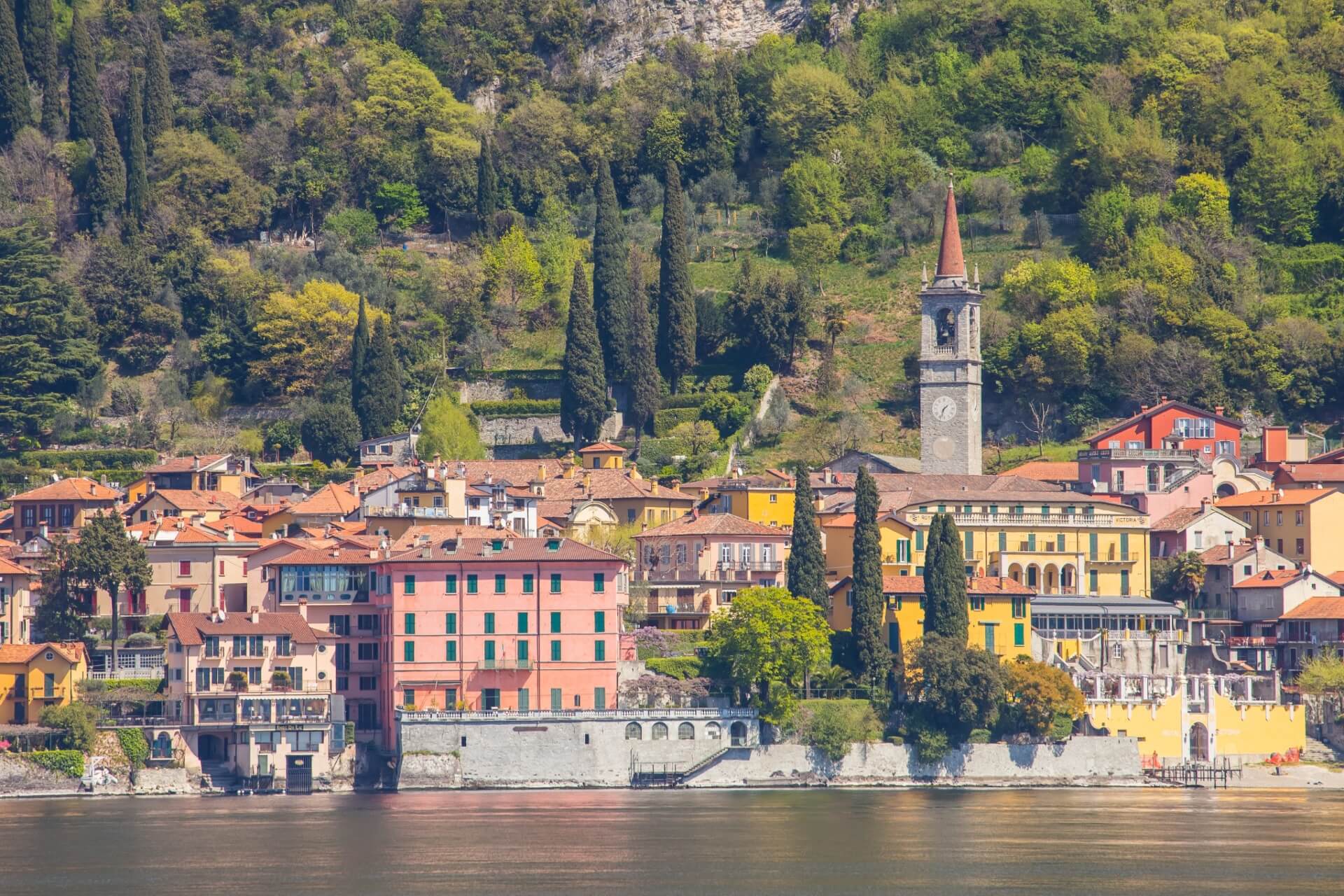
The sunniest town on the eastern shore of Lake Como – Varenna is located on one of the lake’s “branches.” The locals (900 people) are known for their cheerful and joyful disposition. Their houses, like in Venice, are close to the water, and boats literally dock at the doorsteps. Trains Re 8 run to Varenna, covering 70 km in 1 hour and 3 minutes. Tickets can be purchased from machines or at the ticket offices.
For several centuries, marble has been mined in Varenna, which explains the strength of its residents’ character. One of the historical monuments is the Castello di Vezio castle from the 11th century, or rather, the surviving fragments: a wall and an observation tower. Tourists climb the top of the tower via a suspension bridge and admire the views of the lake. Walking along the path around the castle, you cannot help but be amazed by the incredibly beautiful flower garden. Today, the castle houses a falconry farm where birds of prey are bred.
The beautiful villas Monastero from the 3rd century, Cipressi from the 15th century, in the antique style, are delightful. A perfect example of Italian architecture – the church of St. George, listed as a UNESCO World Heritage Site, is also interesting. Among the natural attractions of Varenna is the shortest river in Italy, Fiumelatte (Milk River), 250 meters long. Each stone-paved winding alley is a unique monument of Varenna. Each house with brightly painted facades with ivy-covered arches looks like a souvenir.
Lugano
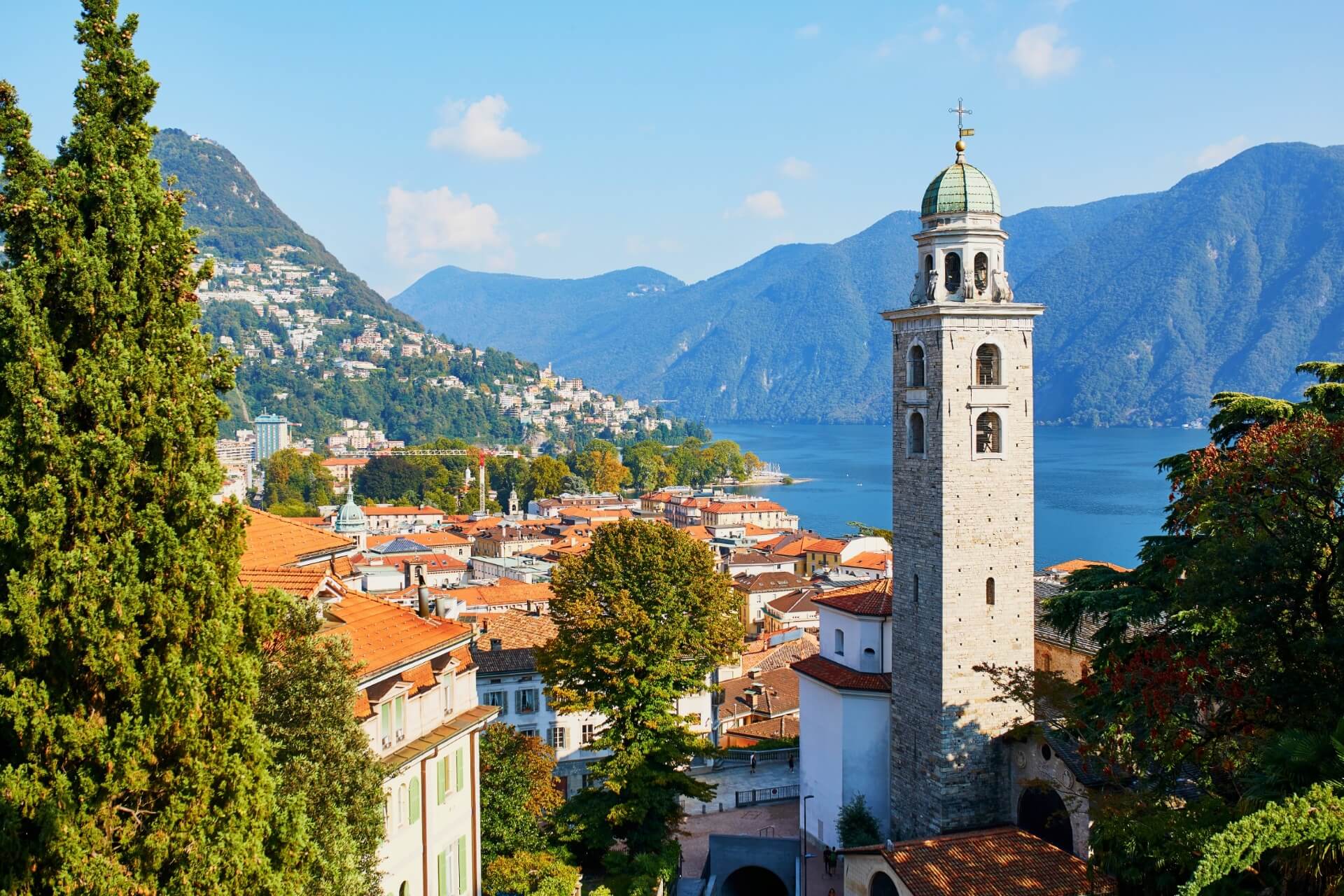
The city of the Italian part of Switzerland, Lugano, located on the shore of the lake of the same name and surrounded by the most beautiful Alps, is worth your attention. In the 9th century, it was a significant trading center. The locals speak Italian. There is plenty to see here besides the magnificent landscapes. The most convenient way to get there is by the new, comfortable N10 electric train.
The journey takes 1 hour and 8 minutes. A walk along the promenade under the shade of plane trees, watching the swans swim, is a mandatory ritual for tourists. City parks, rich in flower gardens and subtropical flora, will give you many bright impressions. Here is the Chocolate Museum, the only one in the world. Visiting the Cantonal Museum of Art, you will get to know many works by Italian and Italo-Swiss masters of painting.
There is also a municipal museum where works by local artists are exhibited. The old church of Santa Maria degli Angioli, with a beautiful fresco by Luini (a pupil of da Vinci), is worth seeing. A visit to the 15th-century church of San Rocco, which has preserved its authentic altar and Discople frescoes, will not be superfluous. You can have a delicious meal in one of the Italian restaurants – they have more choices and lower prices.
Brescia

The ancient city of the Gauls was once the capital of the Cenomanes, allies of the Romans. Many monuments of the Roman, Lombard era, and Mussolini’s rule have become UNESCO World Heritage sites. From the Milano Centrale station to Brescia, electric trains F1 run for 36 minutes, covering a distance of 83 km. It is best to leave early to have time to see the main sights of Brescia. And there are plenty of them.
The old town is a square bordered by boulevards around the perimeter. In the western part is the Cidneo Hill with the castle of the same name surrounded by a park. The central street of Gramsci leads to Vittoria square, designed during Mussolini’s era (1930s). Here, the attention is drawn to the Post Office Palace, flanked by two towers: the Torrione and the Revolution Tower.
On the adjacent Piazza della Loggia, Renaissance buildings from the 15th-16th centuries line up. The luxurious Palazzo della Loggia now houses the town hall. Renowned Venetian architects worked on its design. Opposite the palace is an interesting arched building with the Orologio clock tower at the top. The metal figures of the “timekeepers” strike the bell every hour with hammers. All local buildings are true architectural masterpieces.
Locarno
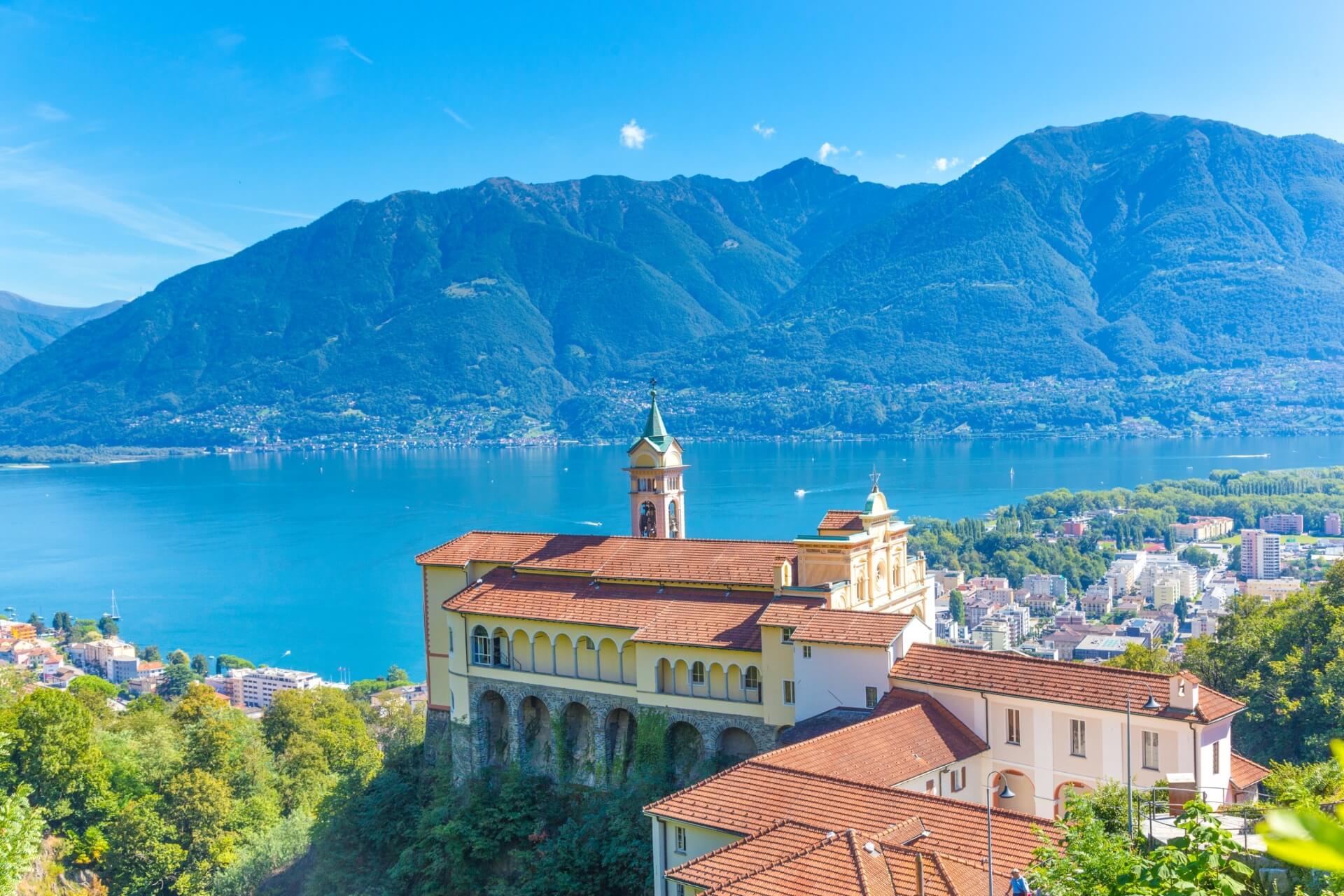
A trip to the Italian-speaking Swiss city of Locarno offers an opportunity to admire the fairy-tale beauty of snowy Alpine peaks, deep gorges with rivers and waterfalls, dense forests, and amazing bridges throughout the journey. Although you need to transfer, this inconvenience is compensated by stunning impressions.
Trains from the Central Station depart every 30-50 minutes to Domodossola. The first train leaves at 6:12 AM, the last one at 9:29 PM, and the journey takes 1.5 hours. From Domodossola to Locarno, panoramic trains take 1 hour and 51 minutes (schedule on the vigezzianacentovalli website). You can return by ferry from Locarno to Stresa (April-October), and from Stresa by train.
Locarno is as delightful as the road to it. The main square, Piazza Grande, is a favorite place for residents and tourists to relax: arches, pizzerias, cafes. To the west of Piazza Grande, in the Visconti castle building, is the Archaeological Museum with Roman Empire relics. You can climb on foot or by funicular to the church of Santuario della Madonna del Sasso, perched on a rock.
If you wish, you can go even higher by funicular. In the historic center, it is worth visiting “Casa Rusca,” an art gallery, palaces, and temples. A walk along the promenade, covered with flower gardens, is pure aesthetic pleasure, as is a visit to any local cafe.

